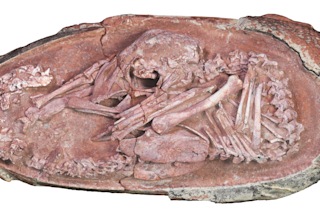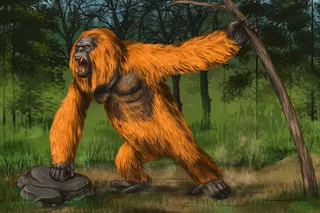Fossilized dinosaur eggs are amongst the rarest finds at dig sites, say experts. Yet, they do exist, and these research treasures can provide important glimpses into the evolutionary process of dinosaur features.
Stephen Brusatte, a paleontologist at the University of Edinburgh and author of The Rise and Fall of the Dinosaurs, explains that these rare finds have only been made for a limited number of dinosaur species.
“There are many groups of dinosaurs whose fossilized eggs have yet to be found, including famous ones like tyrannosaurs and stegosaurs.”
Some especially valuable eggs hold well-preserved embryos inside them.
Read More: Did All Dinosaurs Lay Eggs?
New Dinosaur Embryo About to Hatch
Such was the case a few years ago, when paleontologists uncovered a fossilized egg of an oviraptorosaur in Ganzhou in southern China.
The remarkable find contained an embryo curled up inside, which paleontologists named “Baby Yingliang.”
“What a remarkable thing, to see a dinosaur captured shortly before it would have hatched,” says Brusatte, who was part of the research team.
Experts say that the mature egg must have experienced unique circumstances that prevented it from hatching sometime between 72 and 66 million years agod.
“[It’s] a little bit sad to be honest, as something must have buried the egg in those days or hours before the little baby would have emerged,” Brusatte adds.
What We Know About Oviraptorosaurs
Oviraptorosaurs were feathery, two-legged theropods that roamed the Late Cretaceous, between 101 to 66 million years ago.
Their name means egg snatcher or egg thief. That’s because the first species described was found lying over a nest, leading paleontologists to believe it died in the process of raiding the hatchlings of another dinosaur.
More recent discoveries, however, have revealed these dinosaurs were equipped with toothless beaks and likely omnivorous, eating a varied diet including fruits, plants and maybe even shellfish.
Read More: How Do Scientists Reconstruct What Dinosaurs Looked Like?
Dinosaur Eggs Hatching Like Birds
A remarkable find in its own right, the Baby Yingliang embryo offered insights into how similar the oviraptorosaur’s hatching process is to that of modern-day birds.
“We were able to look at the pre-hatching posture of a baby dinosaur for the first time and compare it to modern birds,” says Fion Waisum Ma, a paleontologist at the Smithsonian’s National Museum of Natural History.
In a posture known as “tucking” — with its head nestled under its arm and its back curled along the side of the egg — the baby dinosaur reveals a pose that is also seen in birds shortly before they hatch, Brusatte says.
The find led researchers to propose that this pre-hatching behavior seen in chickens and other species today may have originated in non-avian theropods.
A separate find of an oviraptorosaur sitting atop a nest of around seven eggs in a “bird-like brooding posture,” adds more evidence.
Seeking More Dinosaur Embryos
“Because oviraptorosaurs are closely related to the origin of birds, we can say that a lot of features that we thought are unique only to modern birds actually first evolved among dinosaurs,” says Ma, who was also part of the Baby Yingliang research team.
Finding other embryos will help confirm this hypothesis, she says, but those specimens will have to be similarly well-preserved.
“We hope we can have more dinosaur embryos that are very well articulated so that we can look at how the whole body is curled up in the egg, not just examine isolated bones,” she says. “If we have larger sample size, we can test our hypothesis.”
Until such finds are made, Baby Yingliang stands as the most remarkable example of a dinosaur captured in time, right before it hatched to roam the Late Cretaceous world.
Read More: Why One Extraordinary Collection of Dinosaur Embryos Remains Locked Away From Science















